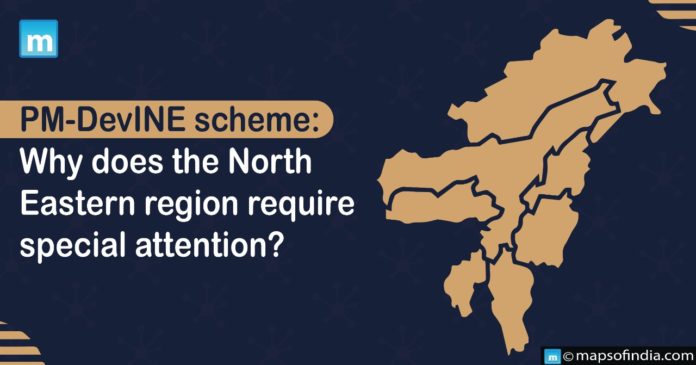The PM-DevINE plan is unique as it concentrates solely on the northeastern states rather than the entire geographical breadth of India. When releasing the Union Budget 2022 – 2023, Union Minister for Finance Nirmala Sitharaman revealed the new program, Prime Minister’s Development Initiative for North-East (PM-DevINE).
Features of the PM-DevINE Scheme
- It will support infrastructure and social development initiatives in the North-East in the style of PM GatiShakti.
- This will enable young people and women to work and fill shortages in various areas.
- Under the PM-DevINE plan, projects can be offered by both the Centre and the North East States; however, initiatives recommended by the states would be given priority.
- The North Eastern Council would execute the PM-DevINE plan.
- The PM-DevINE project would receive an Rs. 1,500 crores first funding allocation.
| Projects | Fund allocated |
| Building of Aizawl Bypass on Western section of the region | Rs 500 crore |
| As a pilot project, the state of Mizoram is building a bamboo link road at several locations in various districts. | Rs 100 crore |
| Establishment of Specialized Services for the Management of Paediatric and Adult Haemotolymphoid Cancers in Guwahati | Rs 129 crore |
| North East Indian Scientific Organic Agriculture Promotion | Rs 45 crore |
| Gap financing for the Pelling-Sanga-Choeling Passenger Ropeway System in Western Sikkim | Rs 64 Crore |
| Livelihood Improvement Project in the North East Centre for Technology Application and Reach (NECTAR) | Rs 67 crore |
| Gap finance for the South Sikkim ropeway (cable car) project from Dhapper to Bhaleydhunga | Rs 58 crore |
| Other projects still need to be identified | Rs 537 crore |
North Eastern region requires special attention because of below mentioned points:
Historically segregated area
- The area never got the focus and attention it deserved because of its seclusion. Before India gained its freedom, the main communication route was through East Bengal, which is today Bangladesh.
- The tribal regions were given a significant measure of autonomy by the British. After witnessing the development of an independent India, the indigenous communities wished to preserve their independence.
- Except for Sikkim, the whole area was formerly a part of the State of Assam, which has since been steadily divided into smaller states and now only occupies a third of its original area.
Poor Infrastructural facilities
- Infrastructure growth in the northeast area is slower than in other states. For instance, Sikkim and Tripura have gradually surpassed and caught up to the national average, although they still lag behind states like Maharashtra and Gujarat.
- Lack of investment and poor infrastructure reinforce one another, restricting the region’s economic growth.
- Numerous forests and delicate ecology further constrain the scope of environmental approvals for infrastructure projects.
Neglected Economically
- The states are undeveloped and have communication problems. There aren’t enough railway lines connecting major locations of all the states, which is a problem.
- Road connection is another issue that is inadequate and susceptible to interruption due to poor weather, landslides, and human activity.
- The Northeastern states’ economic assistance was also insufficient to satisfy the region’s infrastructural and social development needs. A significant percentage of the budget is lost to insurgency, internal terrorism, and international terrorism, as well as illegal immigration.




